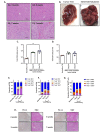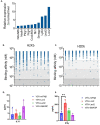This is a preprint.
Chimerization of the Anti-Viral CD8+ T Cell Response with A Broad Anti-Tumor T Cell Response Reverses Inhibition of Checkpoint Blockade Therapy by Oncolytic Virotherapy
- PMID: 38045348
- PMCID: PMC10690324
- DOI: 10.21203/rs.3.rs-3576281/v1
Chimerization of the Anti-Viral CD8+ T Cell Response with A Broad Anti-Tumor T Cell Response Reverses Inhibition of Checkpoint Blockade Therapy by Oncolytic Virotherapy
Update in
-
Expression of tumor antigens within an oncolytic virus enhances the anti-tumor T cell response.Nat Commun. 2024 Jun 27;15(1):5442. doi: 10.1038/s41467-024-49286-x. Nat Commun. 2024. PMID: 38937436 Free PMC article.
Abstract
Although immune checkpoint inhibition (ICI) has produced profound survival benefits in a broad variety of tumors, a proportion of patients do not respond. Treatment failure is in part due to immune suppressive tumor microenvironments (TME), which is particularly true of hepatocellular carcinoma (HCC). Since oncolytic viruses (OV) can generate a highly immune-infiltrated, inflammatory TME, we developed a vesicular stomatitis virus expressing interferon-ß (VSV-IFNß) as a viro-immunotherapy against HCC. Since HCC standard of care atezolizumab/bevacizumab incorporates ICI, we tested the hypothesis that pro-inflammatory VSV-IFNß would recruit, prime, and activate anti-tumor T cells, whose activity anti-PD-L1 ICI would potentiate. However, in a partially anti-PD-L1-responsive model of HCC, addition of VSV-IFNß abolished anti-PD-L1 therapy. Cytometry by Time of Flight showed that VSV-IFNß expanded dominant anti-viral effector CD8 T cells with concomitant, relative disappearance of anti-tumor T cell populations which are the target of anti-PD-L1. However, by expressing a range of HCC tumor antigens within VSV, the potent anti-viral response became amalgamated with an anti-tumor T cell response generating highly significant cures compared to anti-PD-L1 ICI alone. Our data provide a cautionary message for the use of highly immunogenic viruses as tumor-specific immune-therapeutics by showing that dominant anti-viral T cell responses can inhibit sub-dominant anti-tumor T cell responses. However, by chimerizing anti-viral and anti-tumor T cell responses through encoding tumor antigens within the virus, oncolytic virotherapy can be purposed for very effective immune driven tumor clearance and can generate anti-tumor T cell populations upon which immune checkpoint blockade can effectively work.
Keywords: Antigens; B7-H1 Antigen; Carcinoma; Hepatocellular (HCC); Immune Checkpoint Inhibitors; Neoplasm; Oncolytic virotherapy; Transposases; Vesicular stomatitis Indiana virus (VSV).
Figures







References
-
- Llovet JM, et al. Hepatocellular carcinoma. Nat Rev Dis Primers 7, 6 (2021). - PubMed
-
- Rahib L, Smith BD, Aizenberg R, Rosenzweig AB, Fleshman JM, Matrisian LM. Projecting cancer incidence and deaths to 2030: the unexpected burden of thyroid, liver, and pancreas cancers in the United States. Cancer Res 74, 2913–2921 (2014). - PubMed
-
- Finn RS, et al. Atezolizumab plus Bevacizumab in Unresectable Hepatocellular Carcinoma. N Engl J Med, 1894–1905 (2020). - PubMed
Publication types
Grants and funding
LinkOut - more resources
Full Text Sources
Research Materials

